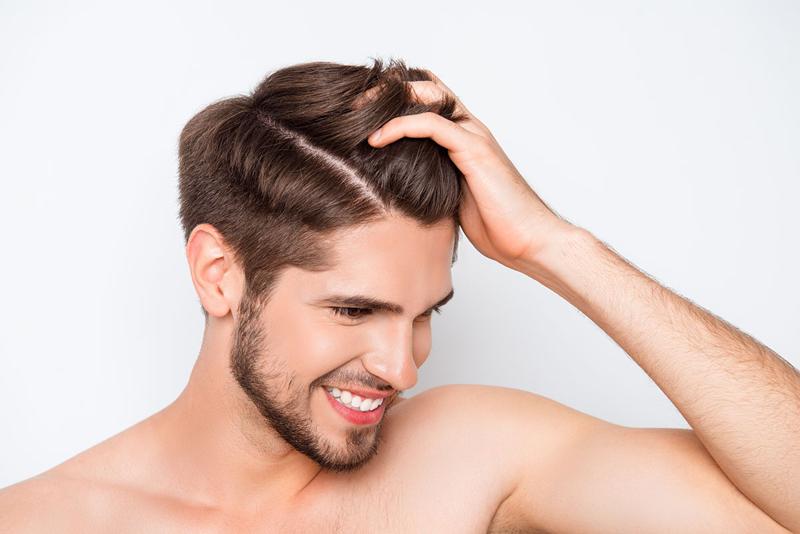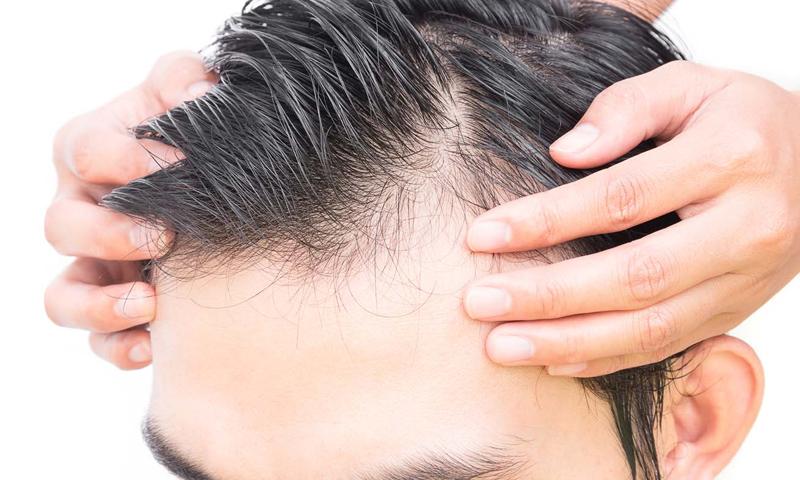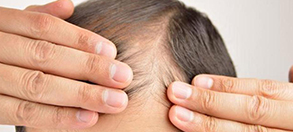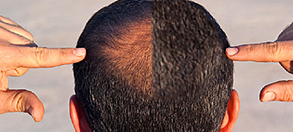Hybrid hair restoration is an approach that involves non-surgical hair restoration, topical and oral treatments in combination with follicular unit extraction (FUE), a surgical hair transplant procedure. By including other therapies in addition to FUE, patients can attain optimal scalp health needed to support their fuller, denser hair following a hair transplant.
In addition to supporting the health of existing follicles, these treatments can help the newly transplanted follicles grow and thrive. Of all the non-surgical hair-reviving options available, autologous conditioned plasma (ACP), topical minoxidil, and finasteride are some of the most effective and heavily relied-on remedies. Other treatments include laser hair therapy, PDO threads, cellular micrografting, scalp micropigmentation, hair vitamins and supplements, and other shampoos, conditioners, serums and topicals. If you have been struggling with confidence issues due to hair loss, the latest resources and technologies can work to revitalize your appearance like never before.
At Houston Hair Transplant Center, our mission is to recreate natural-looking results that will last a lifetime. Our practice is led by Dr. Goran Jezic, an expert and experienced hair transplant specialist who has performed hundreds of successful procedures for over 10 years. As a double board-certified physician since 1996, Dr. Jezic takes into account each patient’s overall health and medical history when formulating their hybrid hair restoration plan.
To find out if this highly personalized hair restoration solution is right for you, get in touch with his practice in Houston, San Antonio or Austin at (713) 864-2300, or fill out his online form, and his staff will be in contact with you shortly to help you schedule a consultation appointment.
What is FUE Hair Transplantation?
Hair transplants are minor surgical procedures physicians can perform in a clinical setting. The premise of the procedure is simple- doctors find a viable “donor” area of hair follicles to harvest from and transplant them into a site of hair loss. Usually, this donor site is the back and sides of the head, and physicians work to carefully remove follicles in a scattered pattern to avoid creating a noticeable bald spot. This is the most common donor site since it is not vulnerable to the effects of androgen hormones, the hormones responsible for androgenic alopecia, commonly called male pattern baldness. Women, too, can experience a form of this hair loss, but it usually shows up in a more diffuse pattern.
With every follicular extraction, physicians take extra care to preserve all structures of the follicle, including the hair “bulb” that contains hair-producing keratinocytes, the arrector pili muscle that can make the hair stand “on-end”, the oil-producing gland, and up to 4 hair shafts. The aim is to avoid transection, i.e. damage to the follicular unit which would compromise the grafts that are implanted into the thinning and balding areas. The hair transplant doctor and his team would then make pinpoint incisions in the crown or hairline and place the follicles into this newly-fashioned pore. The process takes several hours due to the strategic planning and precision required, but every follicle will continue to produce hair and fill in thinning areas of the scalp.
At Houston Hair Transplant, Dr. Jezic only performs the most advanced hair restoration technique, follicular unit extraction (FUE), also known as follicular unit excision (FUE), a procedure that does not require any significant incisions. When compared to follicular unit transplantation (FUT), a more primitive form of the procedure, it creates minimal scarring. With FUT, doctors must remove a strip of skin to retrieve the donor follicles, leaving behind a noticeable linear scar. With FUE, the surrounding hair growth can conceal the donor site, and the scars themselves are only about 1.5 mm in diameter. (1)
ATERA and NeoGraft
NeoGraft and ATERA are the gold-standard instruments for performing accurate, successful FUE procedures. These devices utilize suction pressure to help the physician extract each follicle. After removing the follicle, the device directs it into a tube where it enters a preservation solution. These handheld devices are equipped with micro-punches of various sizes, accommodating all hair types and textures.
Hair Restoration Therapies
Hair restorative therapies range from shampoos to supplements and everything in between. The challenge for most men and women is finding a hair loss treatment that truly works. In addition, those who undergo a hair transplant may want to ensure that they continue to support quality hair growth. By implementing one of these approaches, patients can turn simple FUE into a hybrid restoration that addresses ongoing scalp health.
Minoxidil (Rogaine)
Minoxidil, commonly known as Rogaine, works by activating and increasing the number of growth factors within the scalp. The medication also promotes better-quality vascularization in and around the follicles, so nutrients in the blood can reach the hair-producing structures within each pore. It also slows down the hair growth phases as well, prolonging the anagen phase so that each hair shaft can grow larger in diameter and length. Research states that minoxidil can even increase the size of the follicle pore itself. (2) To be effective, patients need to apply it twice daily, and results will begin to settle in after 4 to 6 months.
Finasteride (Propecia)
Finasteride, also called Propecia, is a once-daily pill that blocks testosterone from becoming DHT (5 alpha-dihydro-testosterone) hormones, the main hormones that cause androgenic alopecia. (3) It is also available in topical form. By reducing the levels of these hormones in the scalp, finasteride helps prevent further hair loss and promotes new hair growth. To be effective, patients need to take finasteride for about 6 months or more. Ask Dr. Jezic about our customized topical compound that contains minoxidil, finasteride, caffeine, peptides and growth factors.
ACP Therapy
Autologous conditioned plasma (ACP) utilizes the healing properties within your blood to create an injection treatment for the scalp, triggering hair regeneration within dormant follicles. For this treatment, also called a “vampire hair treatment”, Dr. Jezic will take a sample of your blood as if it were a standard blood test. They will then process the sample with centrifugation, a purification method that helps them isolate the platelets from the blood. These platelets usually assist with wound healing, but within the context of ACP, they serve a different purpose. Platelets have a variety of growth factor molecules that all help stimulate hair production, including endothelial growth factor, fibroblast growth factor-2, vascular endothelial growth factor, epidermal growth factor, and transforming growth factor β. (4)
When Should I Consider Hybrid Hair Restoration?
Hair restoration is an excellent option if you are looking to replenish hair loss with your very own follicles, but sustaining your results and increasing the treatment’s efficacy is another matter. A hair transplant can help you get started feeling more confident in your appearance and attractiveness, but the blend of implementing medications is more of a commitment to long-term health. The hybrid approach can also help the scalp heal in the weeks after hair transplantation. Studies show that using minoxidil and oral finasteride early after your transplant can help prevent “shock loss”, an effect in which the transplanted follicles temporarily lose connection to their blood supply before regaining it after recovery. (5) Other forms of treatment, -like various supplements- can be powerful for long-term use, but they should be taken with caution since they can have a profound influence on your overall health. You should always take these over-the-counter remedies under the guidance of a healthcare professional to ensure that you take them responsibly.
Regardless of the hybrid methods you opt for, you should always follow your hair transplant clinician’s advice about immediate aftercare and refrain from hybrid methods until your scalp is healed enough. Topical methods are not recommended for those who still have red or inflamed skin from the procedure or another product.
Personal Consultation
During your complimentary consultation appointment with Dr. Jezic at HHTC, you will get a chance to express your hair loss concerns and explore your treatment options for hybrid hair restoration. Aside from minoxidil, finasteride, and ACP therapy, Dr. Jezic can provide you with more advice on supplements, shampoos, and our topical compound. He will only recommend researched products that have substantial evidence to back up their claims. He will also stress the importance of proper preparation and aftercare that will add to the success of your hair transplant.
If you are ready to take your hair transplant experience to the next level, call Houston Hair Transplant Center at (713) 864-2300 or fill out our contact form, and our team will help you schedule an appointment at your earliest convenience. We have offices in both Houston and Austin, TX.
Cost of Hybrid Hair Restoration in Houston
The cost of your hybrid hair restoration at HHTC will depend on the extent of your procedure (number of follicular grafts transplanted), other therapies to support scalp health, and follow-up appointments with your provider. After assessing your unique situation, Dr. Jezic will discuss the total cost of your hybrid procedure during your in-office consultation. If you would like to learn more before scheduling an appointment to get a quote, browse through our blog.
FAQ
What is hybrid hair restoration?
Hybrid hair restoration is an advanced approach that combines surgical and non-surgical hair restoration procedures and solutions to restore hair density and recreate a natural-looking hairline.
What is the most effective non-surgical treatment for hair loss?
To control the progression of hair loss and promote new hair growth, finasteride is one of the most effective treatments. It is available both as a pill and as a topical serum.
How long does it take for hybrid hair restoration to work?
Hybrid hair restoration is a treatment plan that includes a hair transplant procedure and follow-up topical/oral treatments. After around the 3-month mark, you should expect your newly transplanted follicles to begin to show. Topical or oral treatments will likely take a few months to enhance hair growth/prevent further hair loss.
Who is a good candidate for hybrid hair restoration?
Almost any man or woman with patterned hair loss can benefit from hybrid hair restoration. Physicians must be able to identify a donor site of viable follicles; usually, this is the back or sides of the head.
References
- Sharma R, Ranjan A. Follicular Unit Extraction (FUE) Hair Transplant: Curves Ahead. Journal of Maxillofacial & Oral Surgery. 2019;18(4):509-517. doi:https://doi.org/10.1007/s12663-019-01245-6
- Suchonwanit P, Thammarucha S, Leerunyakul K. Minoxidil and its use in hair disorders: a review. Drug Design, Development and Therapy. 2019;Volume 13:2777-2786. doi:https://doi.org/10.2147/dddt.s214907
- Inadomi T. Efficacy of finasteride for treating patients with androgenetic alopecia who are pileous in other areas: A pilot study in Japan. Indian Journal of Dermatology. 2014;59(2):163. doi:https://doi.org/10.4103/0019-5154.127677
- Paichitrojjana A, Paichitrojjana A. Platelet Rich Plasma and Its Use in Hair Regrowth: A Review. Drug Design, Development and Therapy. 2022;Volume 16:635-645. doi:https://doi.org/10.2147/dddt.s356858
- Kerure A, Patwardhan N. Complications in hair transplantation. Journal of Cutaneous and Aesthetic Surgery. 2018;11(4):182. doi:https://doi.org/10.4103/jcas.jcas_125_18




